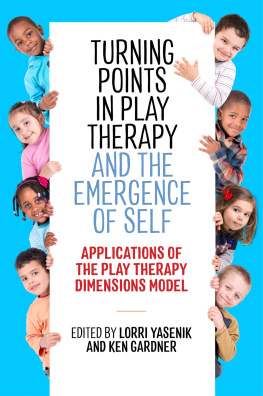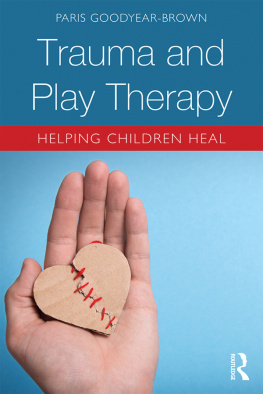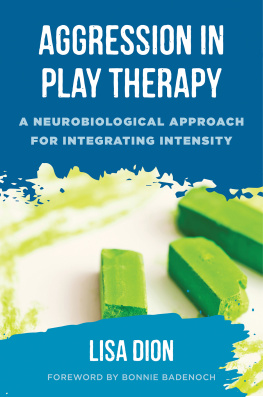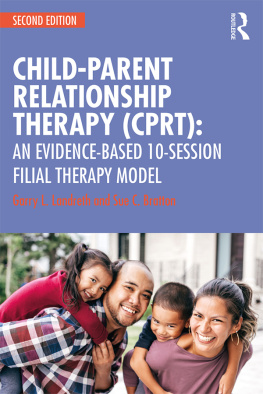
TURNING POINTS IN
PLAY THERAPY AND THE
EMERGENCE OF SELF
Applications of the Play Therapy Dimensions Model
Edited by
LORRI YASENIK and KEN GARDNER

Jessica Kingsley Publishers
London and Philadelphia
Contents
INTRODUCTION
LORRI YASENIK AND KEN GARDNER
This edited book is meant for students, supervisors, instructors, and advanced play therapy practitioners. Anchored by an integrative decision-making framework, the Play Therapy Dimensions Model (Yasenik and Gardner, 2012), each contributor uses the model to illustrate turning points in the play therapy process. Additionally, the impact of the therapists use of self on the emergence of the childs self is examined through detailed case analyses.
A main premise of the book is that effective clinical practice requires a thorough understanding of the ways in which turning points surface in the play therapy process, and how factors such as the therapists use of self contribute to significant movement in therapy. The notion of a therapeutic turning point is not new to the literature on adult psychotherapy. Turning points have been examined for specific clinical issues such as suicide (De Leo, 2010), as well as critical turning points in psychotherapy through detailed retrospective reviews of classical cases in psychotherapy (Schoenewolf, 1990). Unfortunately, the examination of this construct is noticeably absent in the play therapy literature.
To establish a foundation for the reader, turning points must also be considered, such as the emergence of a level of awareness not previously available to a child. Whether a rise in awareness or consciousness occurs at a symbolic or verbal level, its significance lies in the fact that it is something that is useful in the process of change, either in a global sense or in a micro sense.
The play therapist is often the facilitator of turning points and an important partner in the evolutionary journey with the child. To strengthen the practitioners understanding and ability to monitor use of self, contributors explore specific turning points in their clinical cases by using a detailed self-reflective toolthe Degree of Immersion: Therapist Use of Self Scale (. The reader is encouraged to make use of this tool to enhance their clinical practice.
Another premise of the book is that the development of self is a central construct to all restoration, growth, and change. To exemplify this point, a range of referral issues are examined through various models of play therapy including Adlerian, child-centered, prescriptive, integrative, and the Intersubjective and Relational Psychoanalysis approach. Other clinical paradigms are also represented such as the Embodiment-Projection-Role (E-P-R) developmental paradigm (Jennings, 1999), the Learn to Play Therapy approach (Stagnitti, 1998, 2016), and the Flexibly Sequential Play Therapy model (Goodyear-Brown, 2010).
To set the stage for subsequent discussions and case illustrations, provides an overview of important concepts and research on the development of self, including work by developmental/self-concept specialists such as Susan Harter (2012). Making use of developmental frameworks, as well as other theoretical constructs, each expert discusses specific markers that reflect shifts and/or growth in the childs development of self. This discussion is particularly valuable for practitioners and instructors alike, as it occurs in the context of case examples ranging in age from early to late childhood, and with various presenting concerns such as developmental challenges, complex relational trauma, and sexual abuse.
To guide the reader, breaks away from the conceptualization of clinical cases by examining the play therapists development of the professional self. Specifically, this chapter explores contextual barriers to the development of the professional self, along with factors that contributed to growth.
Table I.1 Chapter summary |
Chapter | Primary referral issue and age of child | Theoretical orientation | Phase/length of therapy |
| Four years old; specific language impairment | Learn to Play program |
| Eight years old; behavioral issues | Adlerian | 1.5 years; school-based counseling |
| Five years old; complex trauma | Humanistic; integrative; E-P-R | 73 sessions |
| Four years old; complex trauma | Integrative | 95 sessions |
| Five years old; sexual abuse | Flexibly Sequential Play Therapy | 16+ sessions |
| Three years old; sexual abuse | Adlerian; trauma informed | 19 sessionsdisclosure and treatment |
| Four years old; sexual abuse | Integrative; Intersubjective and Relational Psychoanalysis | Disclosure and initial treatment |
| Seven years old; trauma | Integrative; trauma informed | 42 sessions/two years |
| Six years old; complex trauma | Integrative; trauma informed | +20 sessions |
| 11 years old; relational trauma | Integrative; trauma informed |
| 914 years old; relational trauma; sexual abuse | Integrative | Long-term 100+ sessions |
How to use the material in this book
Ideally, the reader would benefit from first reading , Turning Points and Understanding the Development of Self through Play Therapy, as it provides an overview of the Play Therapy Dimensions Model, the Degree of Immersion: Therapist Use of Self Scale, and, most importantly, the underlying constructs of turning points and emergence of self. However, each chapter stands alone and can be read separately from the other chapters to focus on a specific model or approach, or referral issue. To assist the reader, most chapters conclude with a summary table that chronologically identifies turning points according to the stage in the therapy process, the quadrant(s) in which each turning point occurred (as identified by the Play Therapy Dimensions Model), and factors that contributed to the turning point, particularly the therapists use of self. The summary table alone will assist the play therapy practitioner in their case conceptualization skills.
Play Therapy Dimensions Model (Yasenik and Gardner, 2012) is a helpful companion and can be read as a follow-up to this book. Like the original work, the current edited book will appeal to those working at both ends of the play therapy spectrum, from the development of basic play skills to the resolution of complex clinical issues through high levels of awareness and advanced play skills, cognition, and language. Throughout, the book highlights the special turning points that happen all along the growth pathway.
Note
The names of clients who appear within case studies or examples have been omitted or changed for confidentiality reasons. Some case studies are based on composite case material.
References
De Leo, D. (2010) Turning Points: An Extraordinary Journey into the Suicidal Mind . Bowen Hills: Australian Academic Press.
Goodyear-Brown, P. (2010) Play Therapy with Traumatized Children: A Prescriptive Approach. Hoboken, NJ: Wiley Publishing.
Next page









